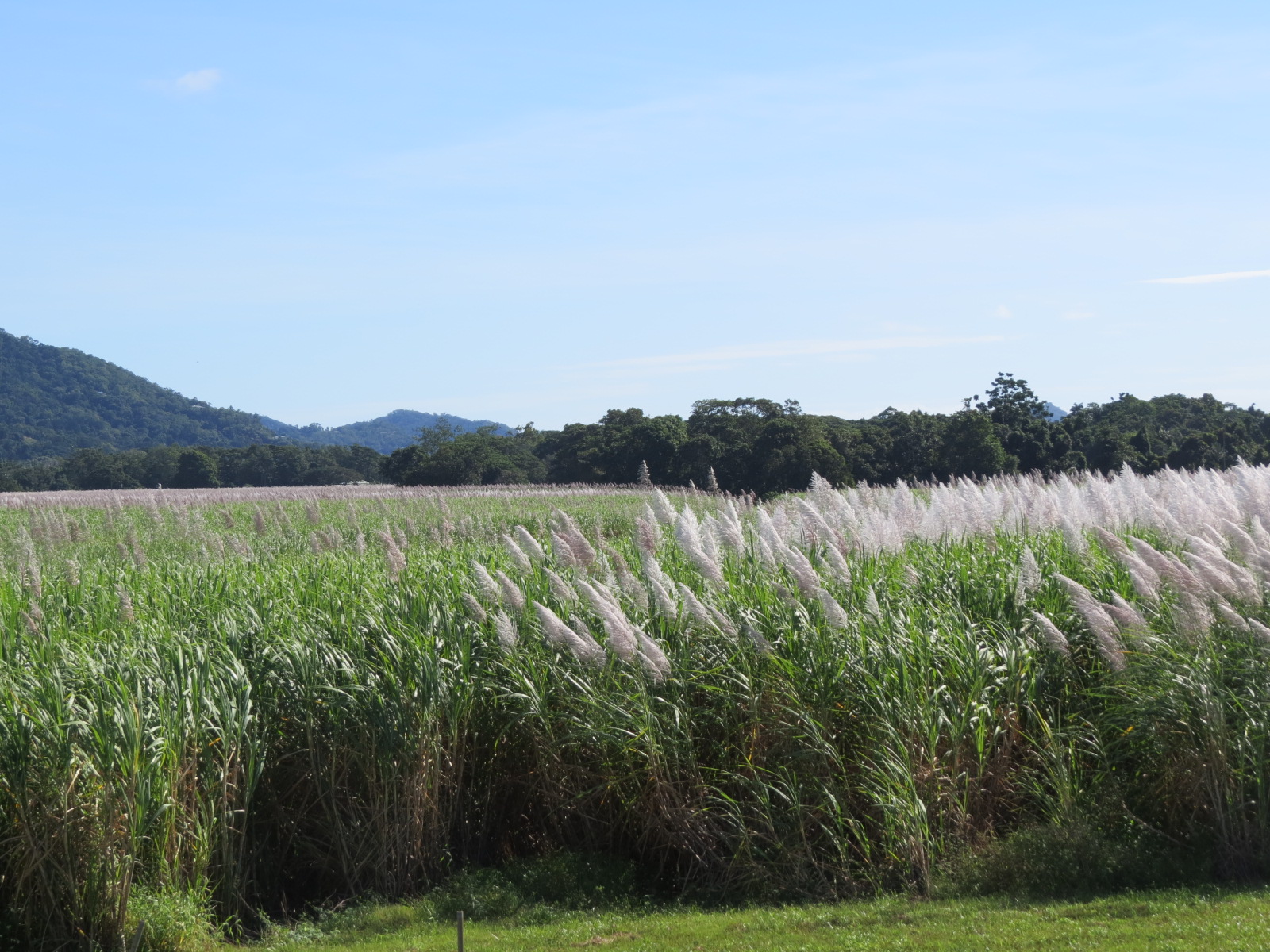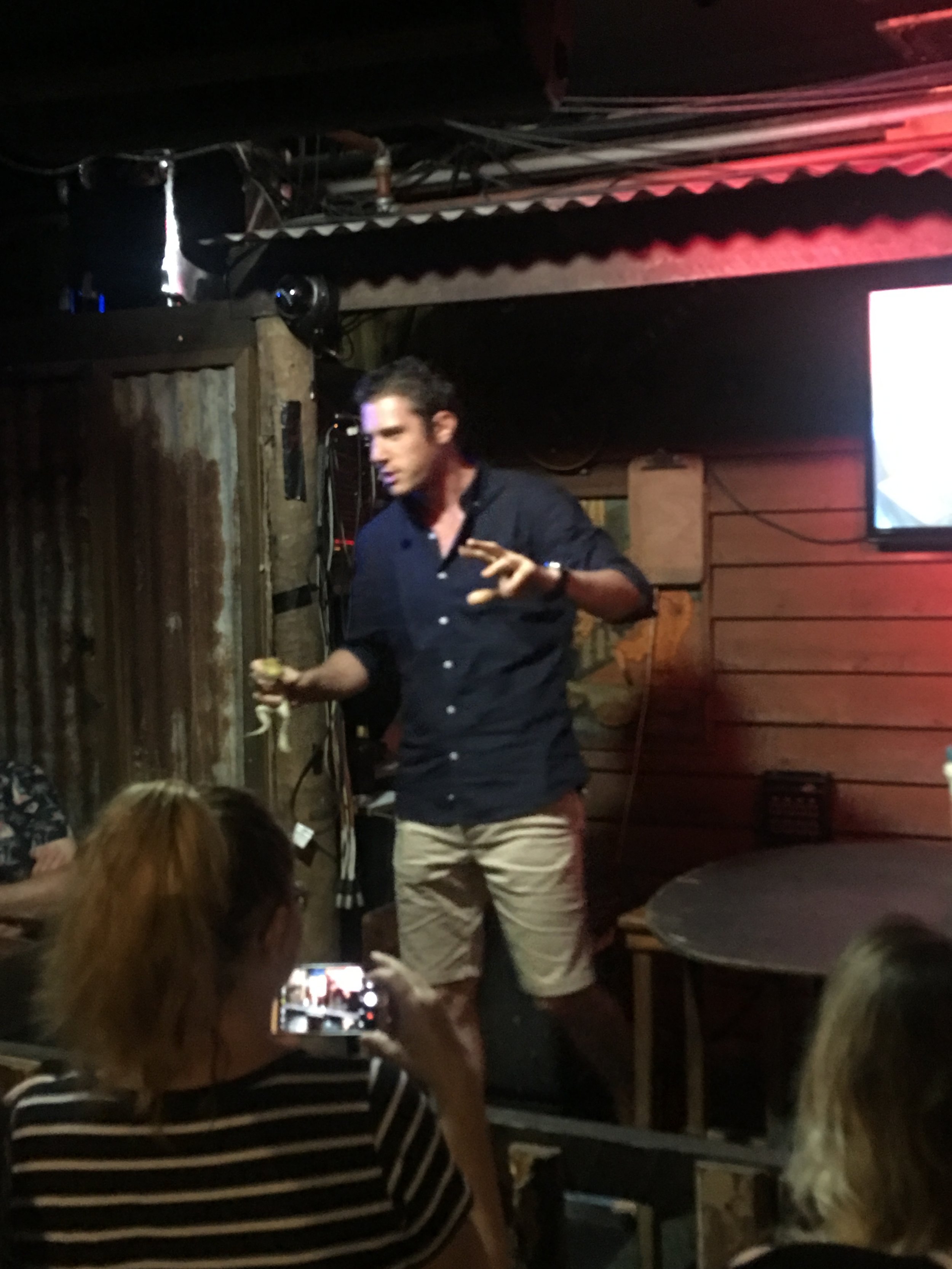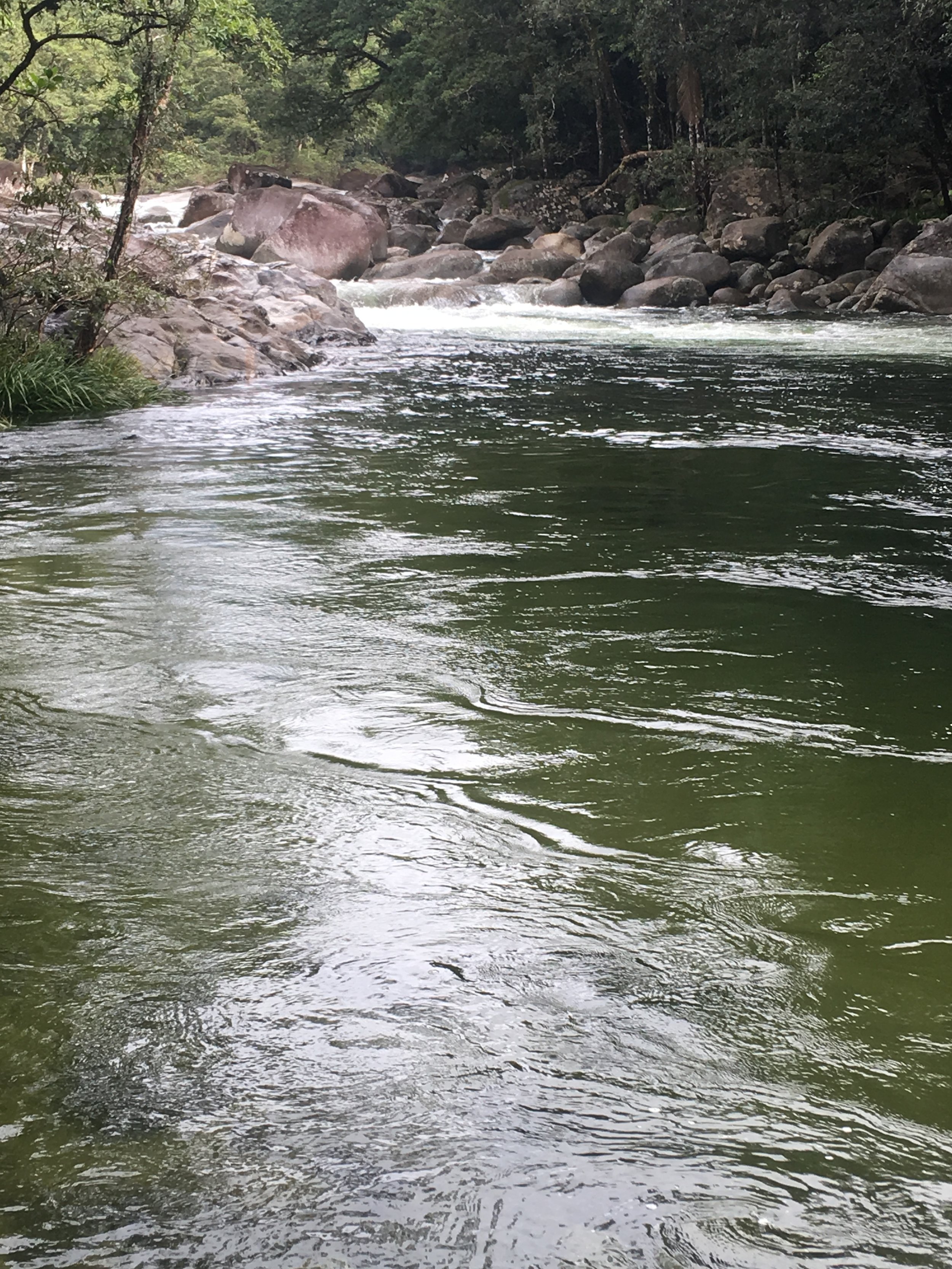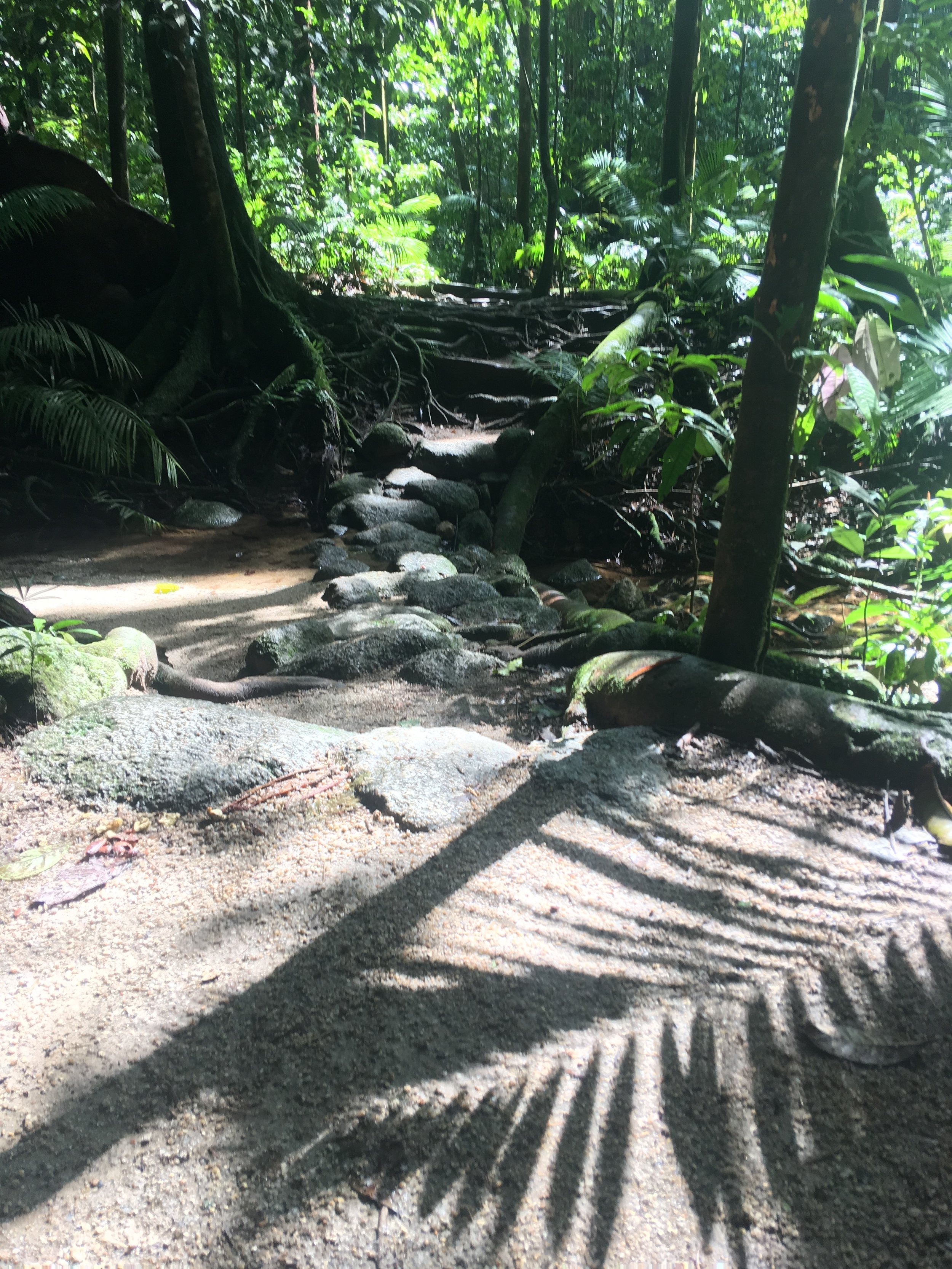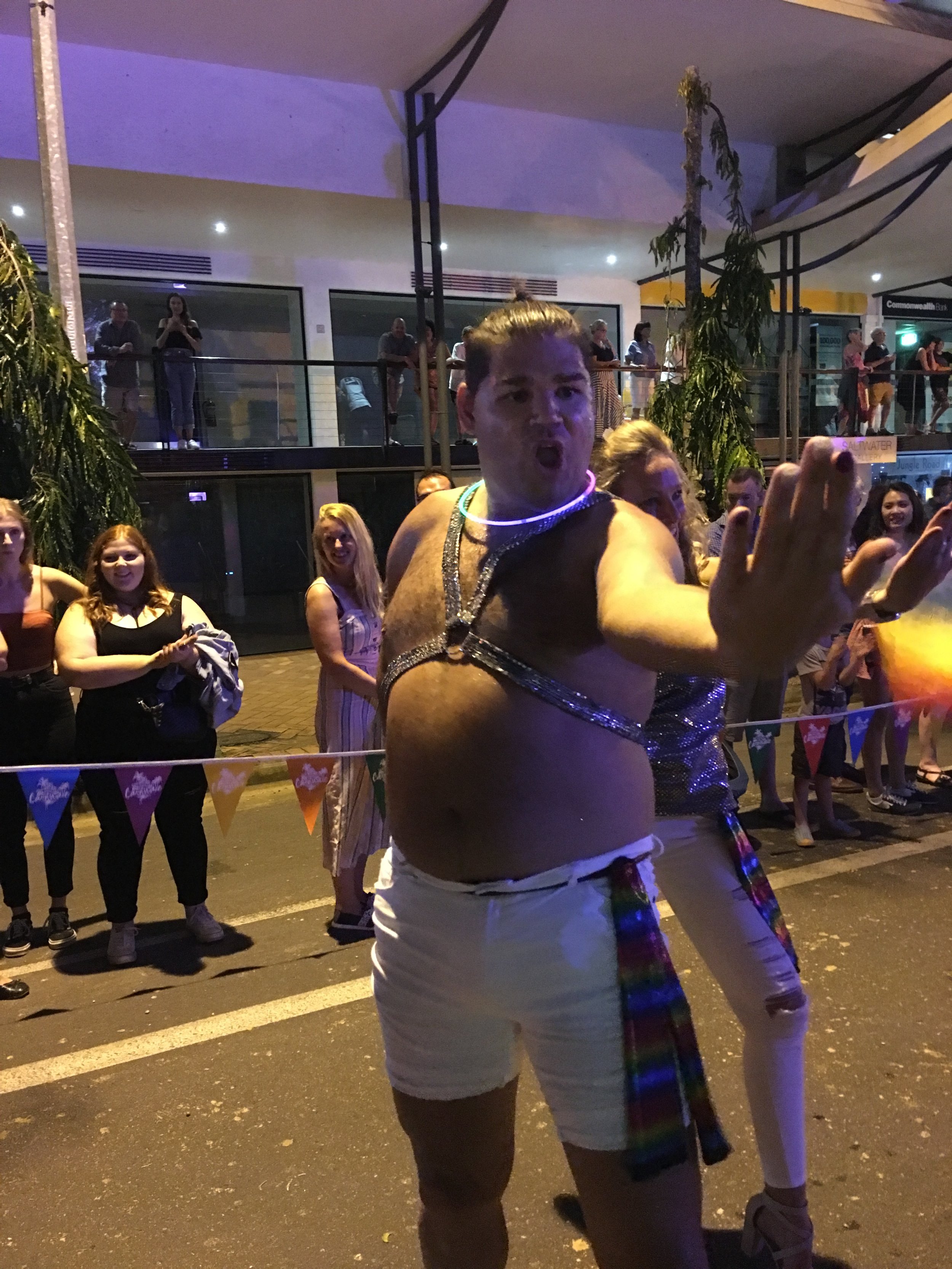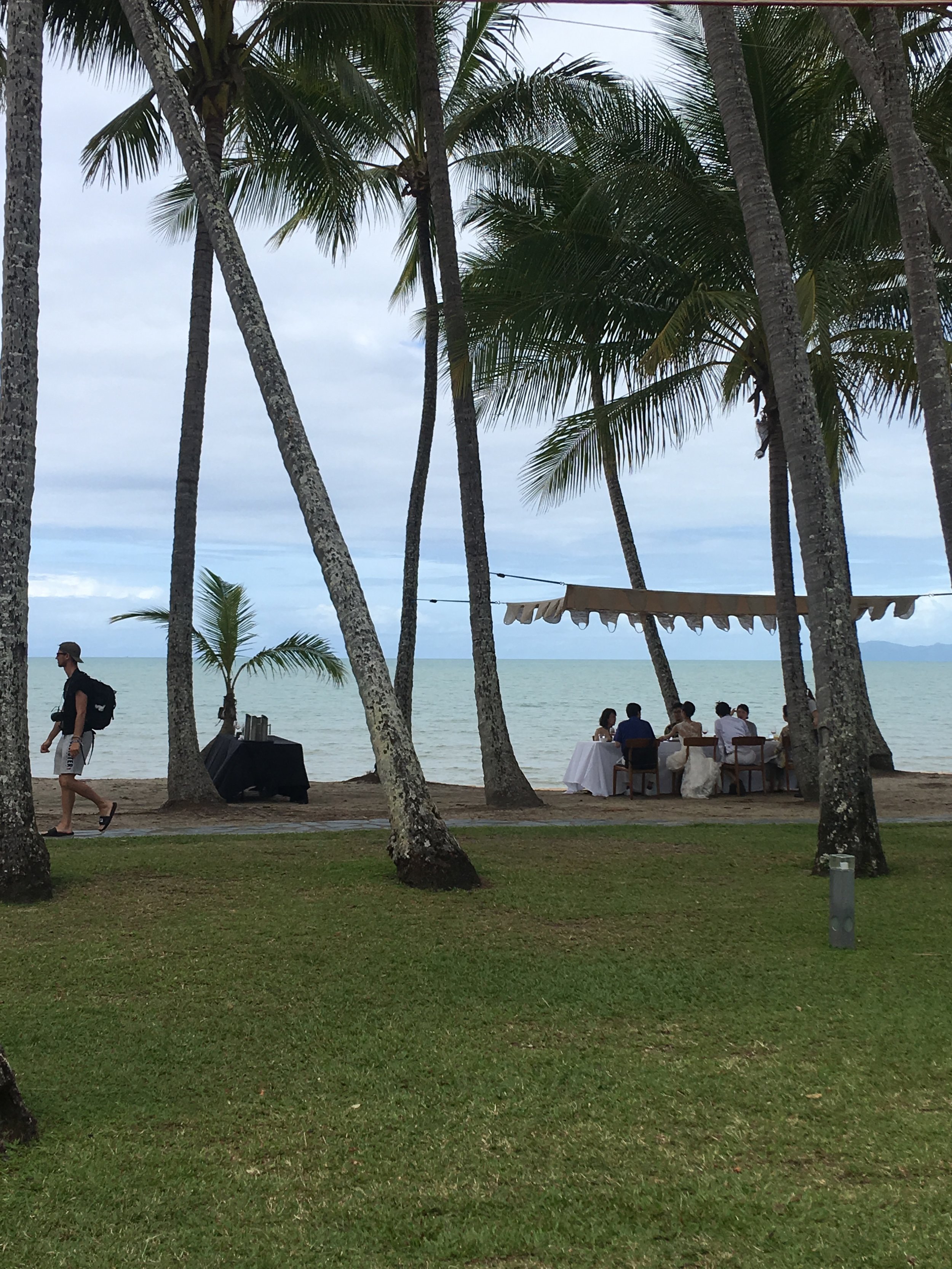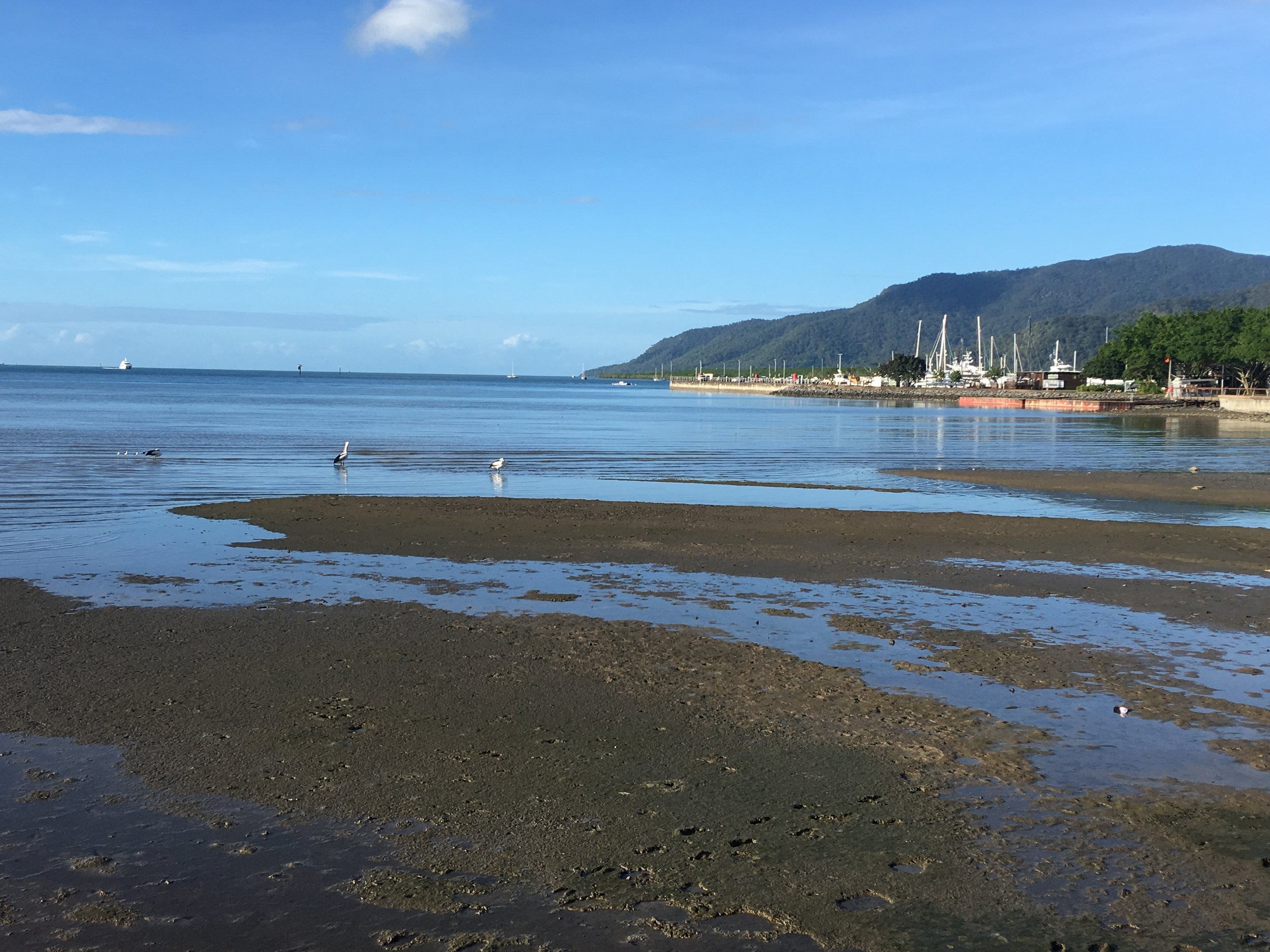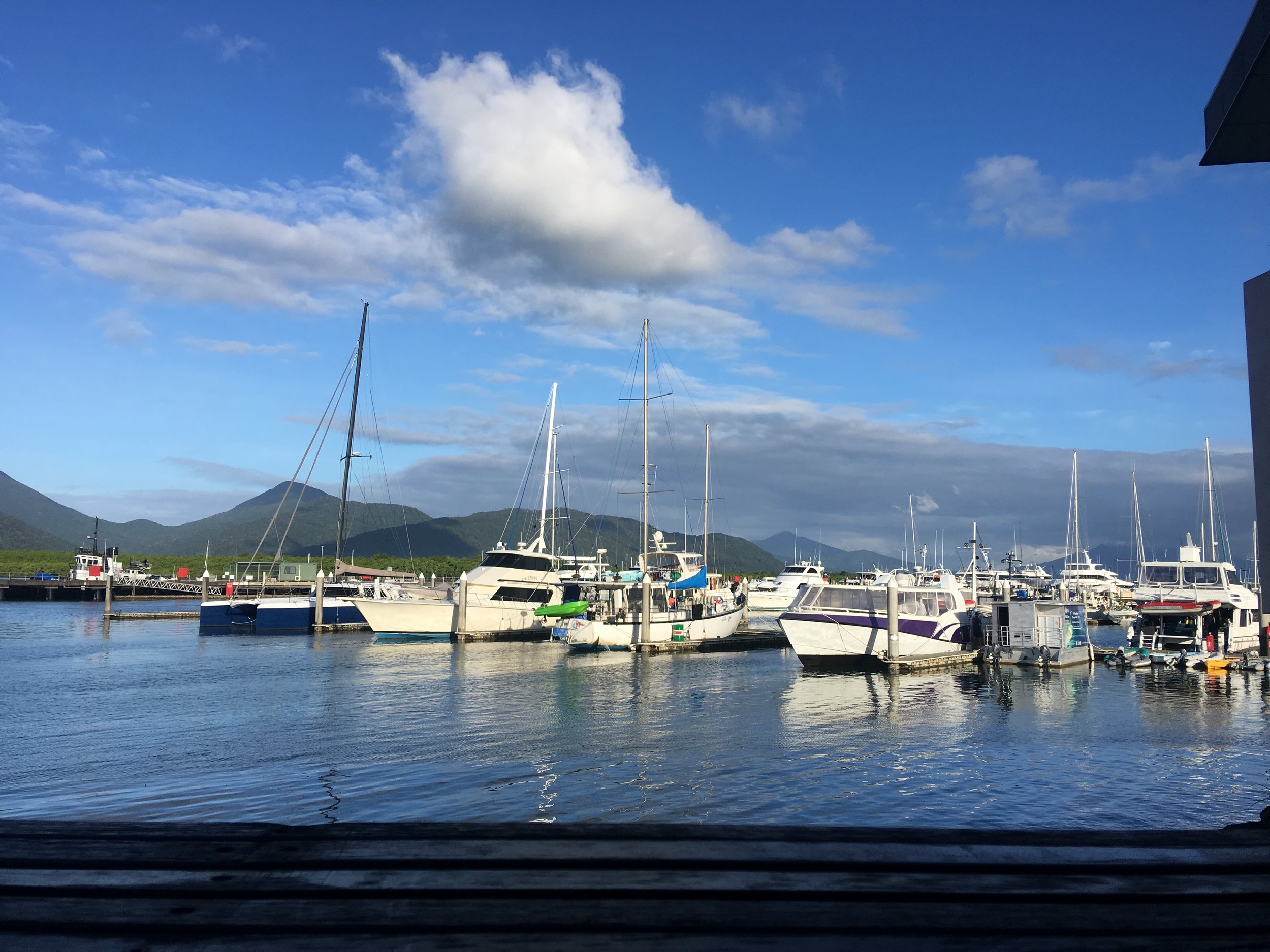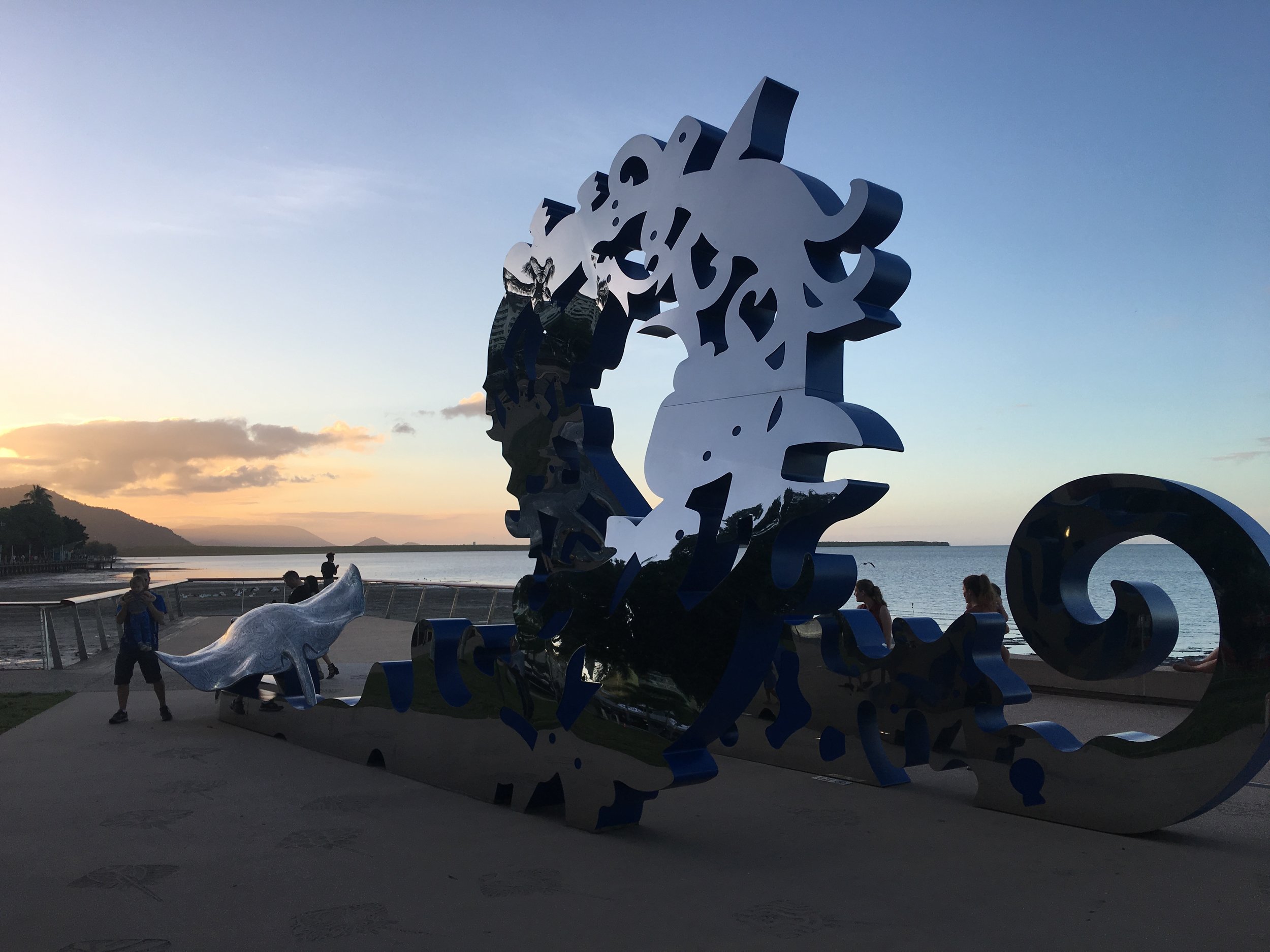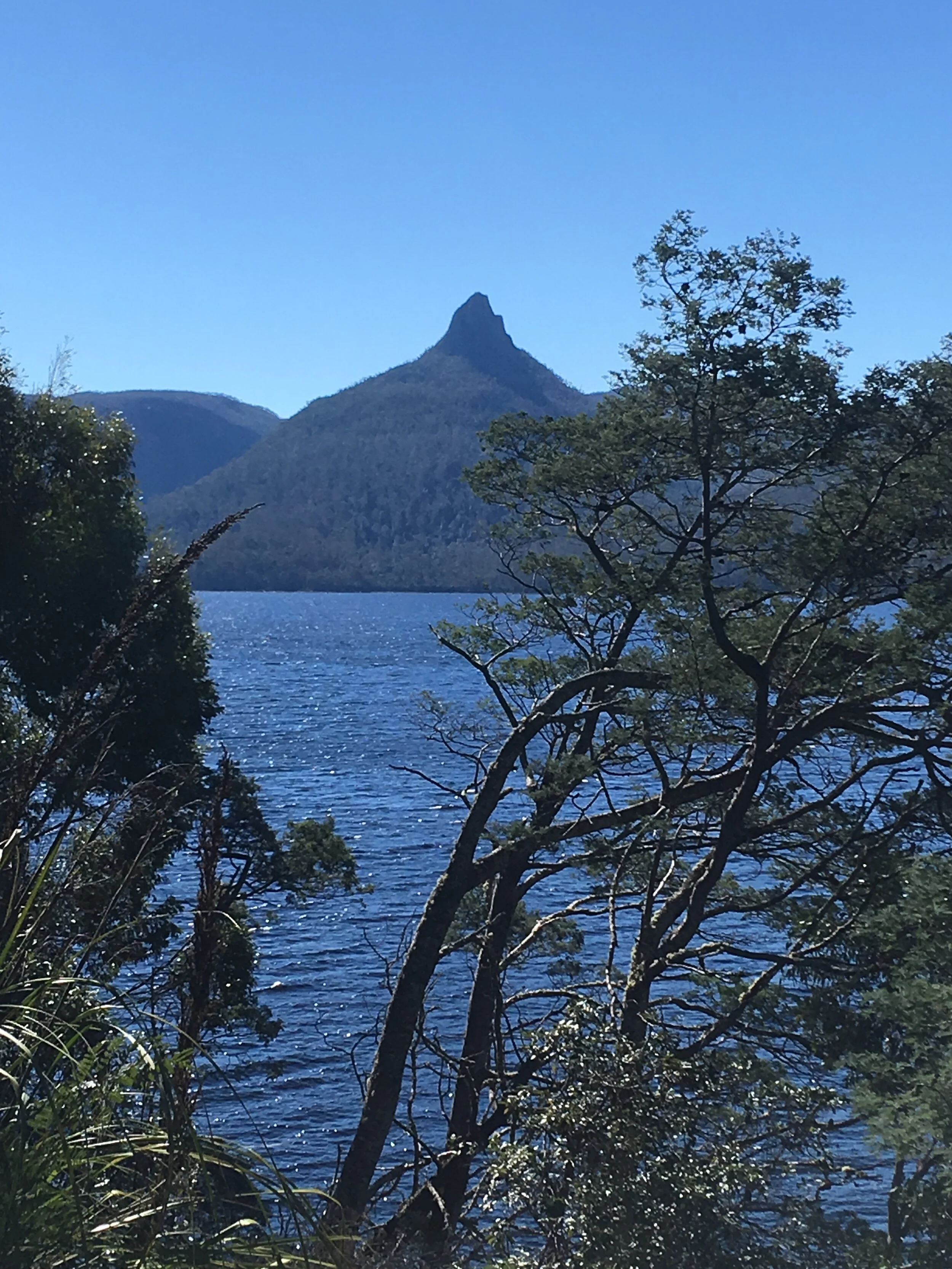Auz16 - Port Douglas and the Great Barrier Reef
While Landy is having a new windscreen fitted in Sydney we have taken a flight North to Queensland to visit the Great Barrier Reef. In late May we were assured that the weather would be balmy, warm and dry.
However, when we landed in Cairns, we were told that rain was forecast for the next week! It must have drifted across from New Zealand. However, it was warm but not unbearable and the rain was actually very intermittent.
On landing, the Cairns tourist board thrust a brochure in our hands recommending not only the Great Barrier Reef, but the Daintree Rainforest and trips to get up close and personal with a crocodile.
The event calendar revealed that in Port Douglas we would be entertained by an Autumn carnival, on the one sunny day, while we were there and now all we need to do is select our barrier reef day, hopefully when it is sunny!
We arrived in Port Douglas via a coastal drive and were shown a couple of cars which had crashed driving too fast on wet roads. These guys have a long rainy season from October to April. This year there had been severe and damaging floods in Northern Queensland, whilst the Southern and interior areas was suffering extreme drought.
We learnt that at this time of year, refugees from Melbourne and Sydney came up for the warmer climate. Some came in campers and others rented holiday apartments. And that this is therefore the start of their peak holiday season. It reminded me of Florida and their many ‘snowbirds’.
The scenery was green and tropical and there are many palm trees and Mangroves. Swamps and lakes contained crocodiles and these fellahs were big. Two to three metres in length and protected.
We were regaled with stories of crocs in flooded streets and of aboriginal children bathing in crocodile infested watering holes, apparently because the crocs had not taken a child yet! Fishermen could be fined heavily if they discarded dead fish parts in the harbour as it encouraged crocodiles to hang around for a feed. Yes, they were also in the sea! These creatures had names and our driver knew where to look to find them.
If crocodiles became a nuisance then they could be trapped and relocated to a protected area. I noticed that there were businesses selling crocodile skin leather goods. How does that work?
After dumping our bags, we wandered into town via a strenuous coastal detour! It was just by the beach that we encountered a woman clutching a large and wriggling goose. I wondered if it had been injured. But no, we were introduced to Scuppers the Sea Goose.
He was their life companion and lived with the couple on their boat. Their mission in life is to promote environmental sustainability and campaign for damage reduction on the Great Barrier Reef. Scuppers is very much a part of their narrative and relaxed to be stroked when they stopped to chat. Scuppers has her own Facebook page. No really!
https://www.facebook.com/cairnsmaritimemuseum.org/
This leads to lots of interesting stories about the bird, the life and the sea.
The walk along the coastal path was tropical, with sea views and very hilly.
What struck me were the roots and hanging vegetation which adorned the trees and bushes.
There were occasional splashes of colour where bougainvillea trees leant into the footpath.
We were constantly reminded about scary creatures in the sea, such as deadly jellyfish and the dreaded crocodiles.
It does not exactly fill me with confidence for our planned snorkelling expedition to the Great Barrier Reef!
We were here for a week and it was good fortune that they had their annual street carnival starting at the weekend. Jim found a young journalist canvassing opinions on the street and we found ourselves in the local paper the next day!
However, we were stuck for something to do on a Thursday night, so we shelled out $5 a head to watch toad racing in a pub. This was a dubious affair organised by a guy whose day job was crocodile conservation - I kid you not!
He explained firstly that Cane Toads were regarded as a pest in Australia, and had been introduced to reduce insect infestations of sugar canes. (There were many sugar cane fields lining the roadway).
His line was that 150 cane toads had multiplied into millions and that they were marching and munching their way through Australia.
He did however exhort people participating in this bit of sport to treat the toads with care. Every cane toad was matched with a participant and fitted with a coloured rubber band. This was done with plenty of banter and it had the air of a comedy auction. New Zealanders got plenty of light hearted stick as did most people actually.
Racers had to lift their toad out of a bucket, kiss it without being poisoned by its salivary gland and urge it to jump to the edge of a table when the race began.
They were encouraged to blow a party popper at their toad in the hope of urging it to move more rapidly than the next one. This resulted in toads hopping off the table into a crowded pub and having to be retrieved and placed in bucket. As you can imagine there was plenty of shrieks and general chaos. I guess most people reading this will thoroughly disapprove, but I am telling it how it was!
During the following day we visited Mossman Gorge, a rainforest not far from Port Douglas, which had been awarded a Unesco World Heritage status.
Access was on a well maintained track in a very small part of a larger National Park. It was beautifully done but felt a bit fake, particularly given our experiences over the last 15 months.
It did provide access to a rain forest safely for visitors unaccustomed to long hikes. A two kilometre track was well sign posted and however beautiful it was, it was less rugged than a walk around Shooters Hill Park!
The next evening we had the Port Douglas carnival, kicking off their annual festival and many schools, sports institutions and shops had floats. We stood under a tree which was hanging with bats. They flew in and out as we waited for the noisy floats to pass. Further research revealed that they were Spectacled fruit bats or Flying foxes. They were particularly prevalent in this corner of Queensland but were endangered with only 152,000 remaining.
The noisiest float was the LGTB one which continued later into an after party!
The next day was a big day. We had booked a full day trip out to visit the Great Barrier Reef.
This was really the point of our trip to Port Douglas. And it did not disappoint.
The waters were more cloudy and the fish were less numerous than I had anticipated but nonetheless it was good day out for both snorkelers and scuba divers. There were many experienced dive staff on hand to assist us in exploration of the reef safely. Well done Calypso!🛥.
In addition to many colourful corals and fishes, I was lucky enough to spy a small shark. Equipped with a borrowed underwater camera, I was able to photograph it. The big sharks below are Sonia and Jim clad in snorkelling gear!
On Sunday we spent a lazy day at a seafood extravaganza, at the beautiful Crystalbrook Superyacht marina. There was free outdoor entertainment for children and adults and many stalls selling freshly sourced prawns and other seafood. As far as I could see it was a chance for large numbers of people to relax and drink large amounts of locally brewed beverages. I can confirm that the ice cool alcoholic ginger beer was very tasty.
A temporary petting zoo had been brought in for the children and there was a demonstration on the animals in a local nature reserve, which included a chance for children to pet a crocodile, a black headed Python and a large Macaw.
Our friends Paul and Clemance are still touring Australia in their landcruiser. They are posting the most amazing footage of their trip through deserts. Some seems to be taken from a dash mounted iphone and other overhead photos are obviously from a drone. They are to be found on Facebook under the name All you can East. Very much like our experience in the desert in Northern Victoria.
We still have one more trip to look forward to. On Monday we plan to hire a car for the day and take a small train and cable car through and over the rainforest before we return to Sydney. 🚂🚠
Unfortunately the cable car was out of action on Monday, so we took ourselves off to Palm Cove and met a parrot in a cafe.
Then we had lunch in Nunu for a late birthday celebration for Jim. It is right up there as perfect spots to eat!
In the background there is a small Japanese wedding party having a meal in the most perfect setting. The father of the bride walked past our table to reach the bathroom. Jim said ‘lovely wedding setting’. He said ‘Many dollars!’ And walked on by.
When we left Palm Cove, making sure we were not eaten by any lurking crocodiles, we drove on to Cairns in the late afternoon.
It had a big city feel, but the esplanade was full of people enjoying the sun. There were mud flats, along the front, and signs asked us not to disturb the wading birds who needed to preserve their energy to optimise the chances of surviving their migration, when they lost half their body weight.
Because of the lack of a beach, the Council had created a large leisure pool near the sea wall. Children and sunbathers hung around on the sand and grass.
It was beautifully done and at least there would be no crocodiles or lethal jellyfish, not to mention sharks!
We left as the sun was setting, glad that we had seen it, but happy with our small town spot in Port Douglas.
Our final day in Queensland was a trip on the amazing Kuranda Scenic Railway. In 1873, gold was discovered in the mountains and prospectors flocked to the area to try their luck. However, in the wet season, these communities could be cut off and there were reports of thousands of people starving because food supplies could not reach these remote communities.
In 1885 the Government approved plans to forge a new railroad through the mountains and gorges to connect the communities with the coast. Contracts were let for the works to proceed. There were many set backs and lives were lost in the construction of the tunnels and track. It opened in 1891, some six years later. The many tunnels were excavated by hand and the hardships involved are unimaginable.
The engines and carriages in use today are not original but the carriages date back to the early 1900’s and the locomotives dated back to 1996 and 1970 after they became surplus to requirements on lines in Brisbane.
The locomotives are brightly painted by local Aboriginal artist, George Riley and portray the legends of Buda-Dji the Carpet Snake who was said to have carved out Barron Gorge.
The hour and a half train journey from Freshwater near the coast, up to quirky Kurunda high up in the hills was stunning.
The views of the rain forests on the climb were life affirming and the quick tramp around the hippy shops of Kurunda was fun.
We descended by cable car and we were suspended scarily over the tops of the rain forest canopies.
There were a couple of opportunities to disembark on the way down where you could peer underneath.
The whole circular trip was amazing although pricey and a popular visitor destination. Our trip back from the Freshwater Railway station to Port Douglas was along the stunning windy coastal road.
There were almost more danger warning signs than cars. Obviously the narrow windy coast hugging roads had been the scene of too many car accidents!
The coastal outlook is so beautiful, with no houses or shops, just many miles of tropical trees and greenery. With vistas onto deserted golden sandy beaches, bathed in golden dappled sunlight as the day and our journey draws to a close.









